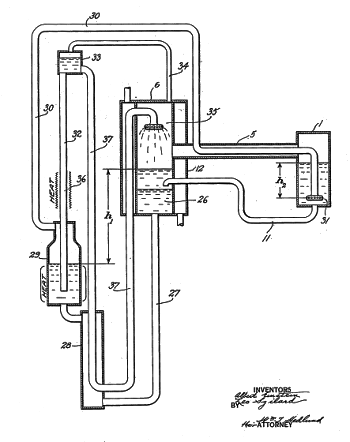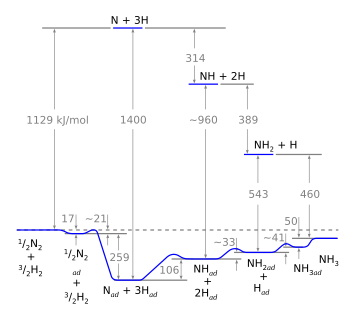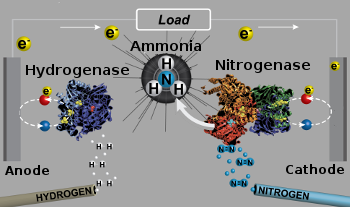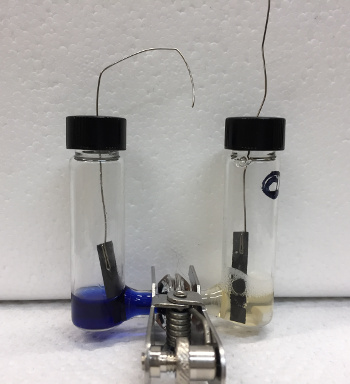Ammonia Synthesis
March 6, 2017
Ammonia is an important
industrial chemical, with nearly 200 million
tons being produced annually. About 14 million tons of ammonia are used to make
nitrate fertilizers,[1] and the rest is used for such industrial applications as
nitriding of
metals,
neutralization of
acids and
stack emissions,
manufacture of
nitric acid for the
synthesis of a variety of chemicals. As anyone who's ever
painted with
latex paint knows, ammonia is used also to
stabilize latex to prevent premature
coagulation.
As a consequence of its low
boiling point (-33.34
°C, -28.0
°F) and high
enthaly of vaporization (23.35 kJ/mol, 5.56 kcal/mol at its boiling point), ammonia is used as an industrial
refrigerant for the preservation of
food,
beverages, and as a way to
freeze skating rinks. For comparison,
water has an enthaly of vaporization of 40.68 kJ/mol, or 9.72 kcal/mol at its boiling point. Because of its
toxicity, you won't find ammonia in your home refrigerator, but home refrigerators using ammonia or the likewise toxic gases,
methyl chloride and
sulfur dioxide, were used about a
century ago.
The hazards of such toxic refrigerator gases inspired
Einstein and his friend,
Leo Szilard, to
invent a safe alternative. As Szilard related to
MIT physicist,
Bernard Feld, Einstein read how an entire
family, the
parents and several
children, had been
killed by leaking refrigerator fumes as they slept.[3] Spurred by this tragedy, the "
Einstein refrigerator" was invented and
patented.[4] While this refrigerator still used the standard gases, it was safer since it had no moving parts and did not require
rotary seals (see figure).

Figure from US Patent No. 1,781,541, "Refrigeration," by Albert Einstein and Leo Szilard, dated November 11, 1930.
The "Einstein refrigerator" is an absorption refrigerator in which the cooling evaporate is absorbed by another liquid, which is run through a heat exchanger to recover the refrigerant liquid for another refrigeration cycle.
(Via Google Patents.[4]
Compounds of ammonia were known to the
ancients, and ammonia is named after the
Greek god, Ammon. Deposits of the ammonia
salt,
ammonium chloride (sal ammoniac), were found near the Temple of Ammon in
Libya.
Pliny the Elder gives a brief mention to ammonium chloride
crystals of that region in his
Naturalis Historia (Natural History) (see figure).

Ammonium chloride (sal ammoniac), as mentioned in Pliny's Natural History, Book XXXI, Chapter 39, line 79.[5] My translation of this reads, "For example, the region of Cyrenaica is notable, also, for hammoniacum, which is found beneath the sands. It is similar in color to the alum which is called schiston, it consists of long masses, not transparent, has a foul taste, but is useful as medicine." (Simulated manuscript created using GIMP.)
Sal ammoniac, as an easily procured chemical, was often used in
alchemy, and it is was mentioned by
Albertus Magnus. It wasn't until 1774 that
Joseph Priestley first isolated gaseous ammonia.
Claude Berthollet determined the
composition of ammonia
NH3 in 1785. Ammonia was produced by simple
reaction of nitrates until the
20th century.
They say, "
necessity is the mother of invention," and such was true for the industrial scale development of the 1909
Bosch-Haber process for ammonia synthesis from
nitrogen gas.
Germany's supply of the
potassium nitrate (saltpeter) from
Chile was thwarted by its enemies during
World War I, but ammonia was an essential compound for synthesis of
explosives. That's when
Carl Bosch of
BASF decided to industrialize the ammonia synthesis discovered by German
chemist,
Fritz Haber.
Any
schoolgirl can write the
equation for synthesis of ammonia from its elements; viz.,
N2 + 3H2 -> 2NH3. While the reaction is
exothermic (-45.9 kJ/mol, -10.97 kcal/mol) and has a favorable
Gibbs free energy change (-16.4 kJ/mol, -3.92 kcal/mol), it does not occur spontaneously, as the existence of free hydrogen and free nitrogen in the
atmosphere affirm.
In 1905, Haber
noted that use of a
catalyst will produced small quantities of ammonia from the elements at 1000 °C. The
catalyst for the Bosch-Haber process was
potassium-doped
iron, formed by addition of
potassium hydroxide to iron, but many other catalysts will work, including
osmium and
uranium. The synthesis is conducted at about 450 °C under 15-25
MPa (2,200 3,600
psi)
pressure.
Ruthenium, when used as a catalyst, allows for a lower pressure reaction. Presently, about 180 million
metric tons of ammonia are synthesized annually by the Bosch-Haber, and similar, processes.[6]

Why we need a catalyst.
Breaking nitrogen and hydrogen molecules into their constituent atoms takes a lot of energy, but all this energy is recovered in the end.
(Wikimedia Commons image by Marsupilami.)
In our
energy-conscious world, there are always
scientists researching ways to make more
energy-efficient chemical syntheses. Since the Bosch-Haber process is an energy-intensive process that's in widespread use, it's a prime candidate for improvement. This does not appear to be an easy task, since no major improvements in ammonia synthesis have appeared in a century. Recently,
chemists from the
University of Utah (Salt Lake City, Utah), the
National University of Ireland Galway (Galway, Ireland), and the
Instituto de Catalisis y Petroleoquimica (CSIC, Madrid, Spain) have developed a new method of ammonia synthesis using a
bioelectrochemical hydrogen-nitrogen
fuel cell.[7-8]

Schematic diagram of a bioelectrochemical hydrogen-nitrogen fuel cell.
(Modified University of Utah image by Ross Milton.)
The key to this novel fuel cell are the natural
enzymes, called
nitrogenase and
hydrogenase, that split nitrogen and hydrogen molecules into their constituent atoms at
room temperature. Nitrogen-splitting is common in nature, where
nitrogen fixation is the natural method of converting nitrogen to ammonia. One small problem with nitrogenase is that it's sensitive to
oxygen, so it must be handled in an oxygen-free environment.[8] The hydrogenase was provided by research team members at the Instituto de Catalisis y Petroleoquimica in Spain.[8]
The nitrogenase and hydrogenase are coupled to the fuel cell
electrodes by an intermediary chemical,
methyl viologen (N,N'-dimethyl-4,4'-bipyridinium), a common
herbicide, that acts an
electron transport medium.[7] The
anode chamber contains hydrogen, the methylviologen, and a purified
metalloenzyme as the hydrogenase. The
cathode chamber contains nitrogen, methylviologen, and a purified metalloenzyme as the nitrogenase.[8] The chambers are coupled by a
proton exchange membrane, and they contain
carbon paper electrodes through which a low
voltage is applied, causing the cell to generate a small
current by the chemical reaction.[8]

Working hydrogen-nitrogen fuel cell.
Carbon paper electrodes are used for the anode (left) and cathode (right).
Methyl viologen is used as an electron carrier in each half-cell.
(University of Utah image by Ross Milton.)
In
experiments, passage of a 60
millicoulomb charge through the cell produced 286
nmol NH
3 per
milligram of
MoFe protein, corresponding to an
efficiency of 26.4 %.[7] Although the ammonia yield at this time is very small, it's a process that produces, rather than consumes, energy. Says
Shelley Minteer, a
chemistry and
materials science and engineering professor at Utah and an author of this study,
"It's a spontaneous process, so rather than having to put energy in, it's actually generating its own electricity."[8]
References:
- World Fertilizer Trends and Outlook to 2018, Food and Agriculture Organization of the United Nations, Rome, 2015 (PDF File).
- Ammonia Data Page, Wikipedia.
- Gene Dannen, The Einstein-Szilard Refrigerators, Scientific American, January 1997, pp. 90-95.
- Albert Einstein and Leo Szilard, "Refrigeration," US Patent No. 1,781,541, November 11, 1930.
- Pliny the Elder, "Naturalis Historia," Book 31, Chapter 39, on the University of Chicago Penelope web site by Bill Thayer.
- Venkat Pattabathula and Jim Richardson, "Introduction to Ammonia Production, American Institute of Chemical Engineers, September, 2016.
- Ross D. Milton, Rong Cai, Sofiene Abdellaoui, Dónal Leech, Antonio L. De Lacey, Marcos Pita, and Shelley D. Minteer, "Bioelectrochemical Haber–Bosch Process: An Ammonia-Producing H2/N2 Fuel Cell," Angewandte Chemie International Edition, February 3, 2017, DOI: 10.1002/anie.201612500.
- Paul Gabrielsen, "Flipping the Switch on Ammonia Production," University of Utah Press Release, February 3, 2017.
Permanent Link to this article
Linked Keywords: Ammonia; industry; industrial; chemical compound; short ton; nitrate; fertilizer; nitriding; metal; neutralization; acid; flue-gas stack; stack emission; manufacturing; manufacture; nitric acid; chemical synthesis; painting; paint; acrylic paint; latex paint; stabilizer; stabilize; latex; precipitation; coagulation; boiling point; celsius; °C; Fahrenheit; °F; enthaly of vaporization; refrigerant; food; beverage; freezing; freeze; ice rink; skating rink; water; toxic; toxicity; chloromethane; methyl chloride; sulfur dioxide; century; Albert Einstein; Leo Szilard; invention; invent; Massachusetts Institute of Technology; MIT; physicist; Bernard Feld; family; parent; child; children; death; kill; Einstein refrigerator; patent; patented; radial shaft seal; rotary seal; absorption refrigerator; heat exchanger; Google Patents; chemical compound; ancient Greece; ancients; Greek god; acid salt; Sal ammoniac; ammonium chloride; Libya; Pliny the Elder; crystal; Naturalis Historia (Natural History); translation; GIMP; alchemy; Albertus Magnus; Joseph Priestley; Claude Berthollet; empirical formula; composition; chemical reaction; 20th century; necessity is the mother of invention; Haber process; Bosch-Haber process; nitrogen gas; Germany; potassium nitrate; Chile; World War I; explosive material; explosives; Carl Bosch; BASF; chemist; Fritz Haber; schoolgirl; chemical equation; exothermic reaction; Gibbs free energy; atmosphere; Haber process; catalysis; catalyst; potassium; iron; potassium hydroxide; osmium; uranium; pascal; MPa; pounds per square inch; psi; pressure; ruthenium; metric ton; nitrogen; hydrogen; molecule; atom; energy; potential energy diagram for ammonia synthesis; Marsupilami; energy conservation; energy-conscious; scientist; research; energy conversion efficiency; energy-efficient; University of Utah (Salt Lake City, Utah); National University of Ireland Galway (Galway, Ireland); Instituto de Catalisis y Petroleoquimica (CSIC, Madrid, Spain); bioelectrochemical reactor; fuel cell; schematic diagram; Ross Milton; enzyme; nitrogenase; hydrogenase; room temperature; nitrogen fixation; oxygen; electrodes; paraquat; methyl viologen (N,N'-dimethyl-4,4'-bipyridinium); herbicide; electron transport chain; electron transport medium; anode; metalloenzyme; cathode; proton exchange membrane; carbon; paper; voltage; current; fuel cell; carbon; paper; electrode; anode; cathode; electron carrier; half-cell; Ross Milton; experiment; coulomb; millicoulomb; electric charge; mole; nmol; milligram; MoFe protein; energy conversion efficiency; Shelley Minteer; chemistry; materials science and engineering; professor.